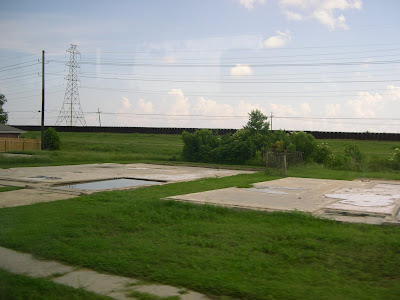 In spite of the many problems plaguing New Orleans, there is also another side, the side promoted by the tourist business. In this column, I've talked about the fun side of the city and the fact that there is much to see and do, even if you do not consider yourself a "party person."
In spite of the many problems plaguing New Orleans, there is also another side, the side promoted by the tourist business. In this column, I've talked about the fun side of the city and the fact that there is much to see and do, even if you do not consider yourself a "party person."-----
I’ve been in New Orleans this past week for a convention with the National Society of Newspaper Columnists. The party never stops in New Orleans. The people are tourist-friendly and the visitors’ bureau is jazzed you are there.
The French Quarter is a quaint area of town where brightly-colored buildings have wrought iron balconies and flower boxes. The streets are very narrow since they were built in the 1700’s. In the evenings, bars are wide open and streets crowded with young people and pick pockets.
New Orleans’ summer weather is so hot and steamy that my hair immediately frizzed like an SOS pad. A walk down the street gave me a hot flash that even a pink hurricane in a souvenir glass couldn’t cool.
Everyone gives you strings of Mardi Gras beads to wear, which help identify you as a tourist. There is a mime, clown, human statue, or jazz musician on every corner working for tips. They seem to have more entrepreneurs per square foot than tourists.
The fact that I had a camera around my neck and stopped to take a picture every two feet probably helped to identify me as an easy mark. There were so many tourists in the French Quarter that it was hard to tell if you were tipping the locals or each other. Everybody had their hand out.
However, the street people all worked, entertained you, played music or posed with you for an unforgettable snapshot for the folks back home. One clown told me I could probably sell his picture on eBay. I guess he forgot that clowns don’t talk.
Horses and carriages give picturesque tours of the city. You can also take an old-fashioned streetcar which runs down the tracks in the middle of Canal Street, but you have to get off and change streetcars to come back. It helps if you can remember which side is downtown and which side is up.
When the wild partying starts in the Quarter at night, old people like me go back to the hotel to growl about the noise, sirens, and cursing in the streets. But even the hotel had a Carousel Bar that revolved like a merry-go-round and made you a bit dizzy whether you were drinking or not.
One evening a brass jazz band led us through the streets to our evening event, and we followed in a New Orleans tradition called “second lining”. I’m sorry I didn’t get a picture but I was too busy twirling my umbrella. Even the crowd on Bourbon Street stopped to watch when we boogied by.
Walking down Bourbon Street one morning to check out the cheap souvenir shops, I saw a dog asleep on the sidewalk while his owner apparently visited a local watering hole. I took his picture and he didn’t even open an eye. I’m surprised he didn’t have a tip jar.
In the shops, the price is never the price. If you hesitate, the price begins to go down. I went to the French market one afternoon where I found a cool copper bracelet, which is supposed to help arthritis, at least according to the guy who sold it to me. Maybe I should have bought a voodoo doll. They were cheaper and no telling what I could have cured with one of those.
They have wonderful food and restaurants and a soup called gumbo that is full of shrimp, seafood and rice. They say you just have to eat it and not worry about what’s in it. They eat crawdads there, although they have changed the name to crawfish to make them more appealing.
Our hotel was believed to have ghosts and I intended to check it out at about midnight. Unfortunately, I was so tired by nighttime that I couldn’t stay awake late enough. I did notice, however, that the elevator had no thirteenth floor.
I’m still trying to recover from the trip. All the tourist areas are back up and running like normal since Katrina and I definitely recommend it as a great place to visit.
And, if you enjoyed my column, just put a dollar in my tip jar.
Copyright 2008 Sheila Moss
http://www.humorcolumnist.com
































